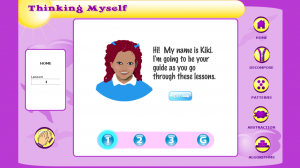Year: 3/4
Strand: Digital Technologies processes and production skills
Substrand: Investigating and defining
Define simple problems, and describe and follow a sequence of steps and decisions (algorithms) needed to solve them.
Link to the resource: http://games.thinkingmyself.com/
Thinking Myself is a straight-forward game consisting of a series of lessons teaching the key ideas of computational thinking. Kiki guides students through the game as they discover how to decompose, find patterns, abstract and create algorithms to solve difficult problems.
In playing this game myself, I found the language to be very straight-forward and simple to understand. There doesn’t seem to be any sound narration, therefore, I would most likely use this game on the IWB with the whole class as a lesson starter. It would provide a good basis for a whole class discussion to gauge students understandings and possible misconceptions regarding the terminology.
Each lesson begins with a definition of the term (see image below). This is a great point at which to discuss known examples of decomposition with the students and relate them to how computers decompose problems. The lesson example involves breaking down a multiplication sum into a repeated addition equation. This is a very obvious decomposition but a good place to start.
Advantages: What I like about this game is that it very clearly links the ideas of computational thinking not only to machines but to common experiences such as following a recipe. This enables students to relate the use of computational thinking to solving problems they encounter in their everyday lives, therefore cementing their understanding of the key concepts.
Disadvantages: This game requires a flash player, therefore will not work on IOS tablet devices. Additionally, the lack of sound narration is a barrier for students who are less abled in reading or for whom English is an additional language.





